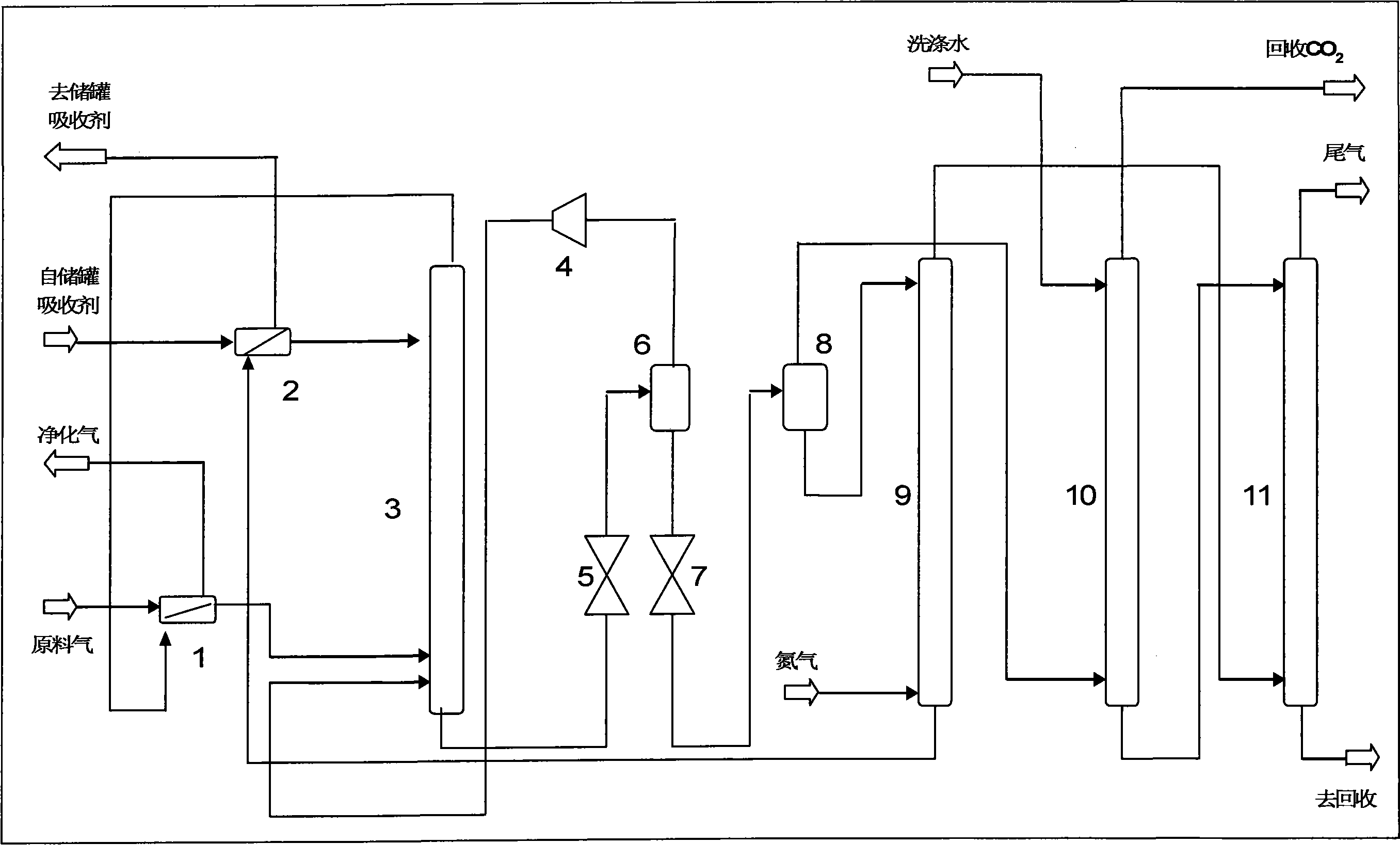Carbon elimination technique using dimethyl carbonate as absorbing agent
A technology of dimethyl carbonate and absorbent, applied in the field of chemical engineering, to achieve the effects of low solvent price, reduced polymerization loss, and reduced equipment investment
- Summary
- Abstract
- Description
- Claims
- Application Information
AI Technical Summary
Problems solved by technology
Method used
Image
Examples
Embodiment 1
[0039] Contains CO 2 The mixed gas has a temperature of 30°C and a pressure of 2800KPa. The composition (mol fraction) is as follows:
[0040] 1-CO2 0.3980
[0041] 2-H2 0.5572
[0042] 3-DMCARB 0.0000
[0043] 4-CO 0.0141
[0044] 5-A 6.2000E-03
[0045] 6-METHANE 3.0000E-04
[0046] 7-N2 0.0237
[0047]8-H2S 5.0000E-04
[0048] 9-H2O 0.0000
[0049] CO removal with absorber overhead 2 After heat exchange, the purified gas drops to 20°C and enters the absorption tower from the lower part, and the dimethyl carbonate from the absorbent storage tank at 30°C exchanges heat with the desorbed circulating absorbent lean liquid and then enters the absorption tower from the upper part after heat exchange to 15°C. The phases contact countercurrently in the column and absorption mass transfer occurs. The gas phase flow rate is 20217.5039KG-MOL / HR, and the liquid phase flow rate is 53376.3621KG-MOL / HR. The temperature at the top of the absorption tower is 14.0°C and the pressu...
Embodiment 2
[0085] Contains CO 2 The mixed gas has a temperature of 30°C and a pressure of 3000KPa. The composition (mol fraction) is as follows:
[0086] 1-CO2 0.3980
[0087] 2-H2 0.5572
[0088] 3-DMCARB 0.0000
[0089] 4-CO 0.0141
[0090] 5-A 6.2000E-03
[0091] 6-METHANE 3.0000E-04
[0092] 7-N2 0.0237
[0093] 8-H2S 5.0000E-04
[0094] 9-H2O 0.0000
[0095] After heat exchange with the purified gas from the top of the absorption tower to remove CO2, it drops to 24.73°C and enters the absorption tower from the lower part, and the dimethyl carbonate from the absorbent storage tank at 30°C exchanges heat with the desorbed circulating absorbent lean liquid to 20°C It enters the absorption tower from the upper part, and the two phases contact in countercurrent in the tower and undergo absorption and mass transfer. The gas phase flow rate is 20217.5039 KG-MOL / HR, and the liquid phase flow rate is 58411.8679KG-MOL / HR. The temperature at the top of the absorption tower is 19.8°C ...
Embodiment 3
[0131] Contains CO 2 The mixed gas, temperature 30 ℃, pressure 3500KPa, composition (mol fraction) is as follows:
[0132] 1-CO2 0.3980
[0133] 2-H2 0.5572
[0134] 3-DMCARB 0.0000
[0135] 4-CO 0.0141
[0136] 5-A 6.2000E-03
[0137] 6-METHANE 3.0000E-04
[0138] 7-N2 0.0237
[0139] 8-H2S 5.0000E-04
[0140] 9-H2O 0.0000
[0141] CO removal with absorber overhead 2 After heat exchange, the purified gas is lowered to 30°C and enters the absorption tower from the lower part. The dimethyl carbonate from the absorbent storage tank at 30°C exchanges heat with the desorbed circulating absorbent lean liquid and enters the absorption tower from the upper part after heat exchange to 25°C. The phases contact countercurrently in the column and absorption mass transfer occurs. The gas phase flow rate is 20217.5039KG-MOL / HR, and the liquid phase flow rate is 62943.8232KG-MOL / HR. The temperature at the top of the absorption tower is 24.8°C and the pressure is 3480KPa; the temp...
PUM
 Login to View More
Login to View More Abstract
Description
Claims
Application Information
 Login to View More
Login to View More - R&D
- Intellectual Property
- Life Sciences
- Materials
- Tech Scout
- Unparalleled Data Quality
- Higher Quality Content
- 60% Fewer Hallucinations
Browse by: Latest US Patents, China's latest patents, Technical Efficacy Thesaurus, Application Domain, Technology Topic, Popular Technical Reports.
© 2025 PatSnap. All rights reserved.Legal|Privacy policy|Modern Slavery Act Transparency Statement|Sitemap|About US| Contact US: help@patsnap.com


